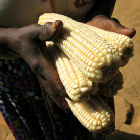Bernard Appiah
2 November 2012 | EN

Intercropping could prove beneficial to farmers across the entire continent
Flickr/M. DeFreese/CIMMYT
Growing leguminous trees on maize farms — a form of agroforestry — can boost and stabilise maize yields, a 12-year study in Malawi and Zambia has found.
The researchers behind the study, from the Kenya-based World Agroforestry Centre and the University of Pretoria, South Africa, say this is the first analysis of long-term crop yield trends in cereal-legume agroforestry systems in Southern Africa.
Maize is a common staple in the region and is grown in more than half of cultivated land in countries across the region, according to the study, published in theAgronomy Journal in September.
But factors such as rapid population growth, continuous cultivation, soil degradation, and climate change threaten maize yields. Given that intercropping (the practice of growing two or more crops in close proximity) generally increases maize yields, the researchers decided to explore whether the gains made could be sustained over the long-term in rain-fed maize-legume agroforestry systems.
The researchers planted the legume Gliricidia in three non-irrigated sites — one in southern Malawi and two in eastern Zambia. The yields from maize–Gliricidia intercropped farms were then compared with those from both fertilised and unfertilised monoculture maize farms in the same three sites.
"We found that maize farms with legume trees had, on average, a 50 per cent increase in yields and that the yields were stable, compared with those grown with or without fertilisers," said Gudeta Sileshi, lead study author and the World Agroforestry Centre's regional coordinator for Southern Africa, based in Malawi.
The researchers said Gliricidia "fixes" nitrogen from the air, converting it into a form ideal for maize growth, thus lessening the need for large doses of manufactured nitrogen fertilisers. Gliricidia also sheds leaves, thus returning organic matter to the soil and increasing the soil's structural stability, erosion resistance, and water storage capacity.
Sileshi added that the findings are applicable to regions where farmers mostly rely on rain for growing maize, including East and West Africa.
Martin Anikwe, commissioner for agriculture and natural resources for Enugu State, Nigeria, commented: "The study is relevant in most of Sub-Saharan Africa, where nutrient mining from the soil and the scarcity of chemical fertilisers leads to low productivity".
But Peter Aagaard, director of the Conservation Farming Unit in Lusaka, Zambia, told SciDev.Net that although legume trees can help stabilise maize yields, caution should be exercised in adopting the maize — Gliricidiaintercropping system because of the excessive and expensive labour involved in pruning the branches two to three times a year.
"Researchers tend to focus on the agronomic benefits of technologies, while ignoring whether they are actually doable by labour-constrained households,"Aagaard said.
He cited the cases of two farmers in eastern Zambia who became involved in maize — Gliricidia intercrop demonstrations, but had now destroyed all the trees, partly because of labour constraints — they found it energy consuming to prune the branches frequently.
'庫間 > 해외자료' 카테고리의 다른 글
| 소의 오줌이 항생제 내성을 퍼뜨린다 (0) | 2012.11.16 |
|---|---|
| 어떻게 대형 돼지농장이 작은 마을을 짜내는가 (0) | 2012.11.16 |
| 소농의 죽음 (0) | 2012.11.05 |
| 당신의 흙을 되살려라 (0) | 2012.10.26 |
| Big, Smart and Green: A Revolutionary Vision for Modern Farming (0) | 2012.10.21 |
